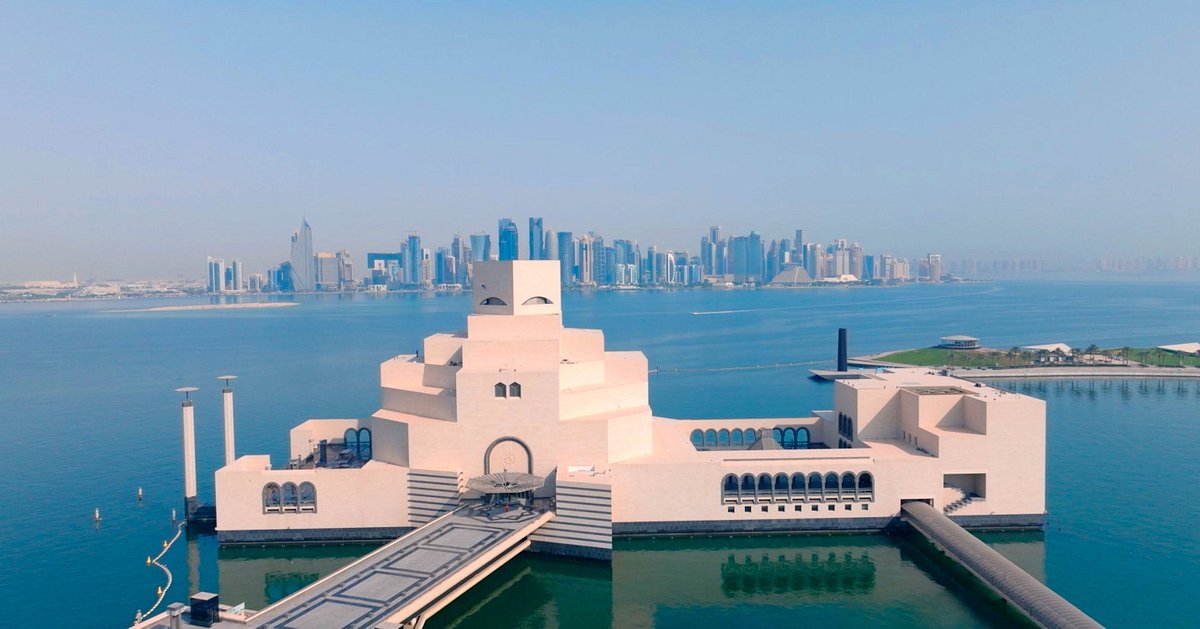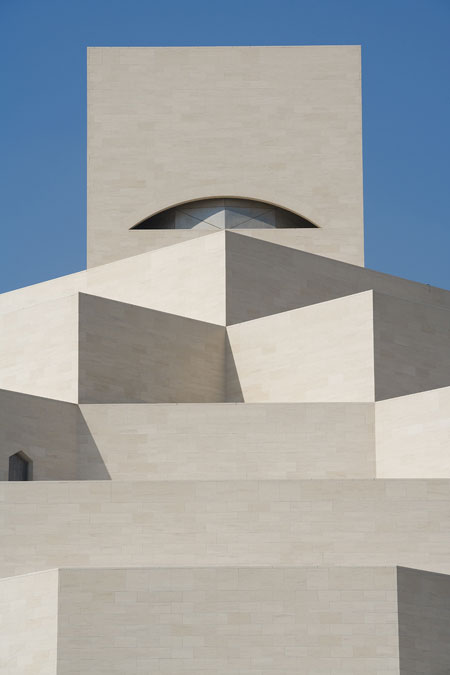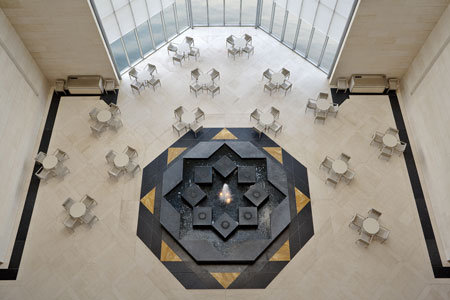A Journey Through Islamic History at the Museum of Islamic Arts

If you're a history enthusiast or simply looking for a unique cultural experience, visiting the Museum of Islamic Arts is a must. Located in Cairo, this renowned museum offers a fascinating journey through Islamic history, art, and culture.
Overview of the Museum of Islamic Arts and its significance
The Museum of Islamic Arts is not just an ordinary museum but a treasure trove of Islamic heritage. The museum houses one of the world's most extensive collections of Islamic art, spanning over 1,400 years. Its collection includes exquisite ceramics, textiles, metalwork, manuscripts, and more.
The significance of this museum lies in its ability to showcase the Islamic world's rich and diverse cultural heritage. It gives visitors a deeper understanding and appreciation of Islamic art and its historical context.
As you explore the museum, you will journey through different periods of Islamic history. Each exhibit tells a unique story from the early Islamic period to the golden age of Islamic civilization. You will have the opportunity to marvel at intricately designed carpets, admire delicate calligraphy, and appreciate the craftsmanship of ancient ceramics.
One of the highlights of the museum is its stunning architecture. Designed by renowned architect I.M. Pei, the building itself is a masterpiece. Its geometric patterns and grandeur reflect the beauty and symmetry often found in Islamic architecture.
Whether you are an art enthusiast or simply curious about different cultures, visiting the Museum of Islamic Arts will leave you inspired and enlightened. It offers a captivating journey through time, providing a glimpse into the Islamic world's rich history and artistic achievements.
So, plan your visit today and embark on an unforgettable journey through Islamic history at the Museum of Islamic Arts.

Islamic Art and Architecture
Exploring the rich history of Islamic art and architecture
If you are a lover of art and history, a visit to the Museum of Islamic Arts is an absolute must. This museum offers a captivating journey through the rich history of Islamic art and architecture.
As you enter the museum, you will be greeted by a stunning collection of artefacts spanning over a thousand years. From intricate calligraphy to mesmerizing geometric patterns, each piece tells a story of the Islamic world's artistic brilliance and cultural diversity.
One of the highlights of the museum is its collection of Islamic architecture. You will have the opportunity to marvel at scale models and replicas of famous mosques, palaces, and mausoleums from different periods in Islamic history. These architectural wonders showcase the unique blend of influences from various regions, resulting in breathtaking structures that have stood the test of time.
The museum also houses an extensive collection of Islamic art, including ceramics, textiles, metalwork, and manuscripts. Each piece is a testament to the craftsmanship and creativity of Islamic artists throughout history. You will be captivated by the intricate designs, vibrant colours, and delicate details that adorn these works of art.
In addition to exploring the exhibits, the Museum of Islamic Arts offers educational programs and workshops that allow visitors to further immerse themselves in the world of Islamic art Whether you are a novice or an expert, these programs provide a deeper understanding of the techniques, symbolism, and cultural significance behind each artwork.
So, if you are looking for a unique cultural experience that takes you on a journey through Islamic history, visit the Museum of Islamic Arts. Prepare to be inspired by the beauty and complexity of Islamic art and architecture as you delve into centuries-old traditions and discover the enduring legacy of this remarkable culture.

A Journey Through Islamic History at the Museum of Islamic Arts
If you are a history enthusiast or simply curious about Islamic culture, visiting the Museum of Islamic Arts is a must. This renowned museum is home to an impressive collection of ancient Islamic artefacts that offer a fascinating glimpse into the rich history of the Islamic world.
Highlighting the collection of ancient Islamic artefacts at the museum
As you enter the museum, you will be greeted by a treasure trove of centuries-old artefacts. The collection includes exquisite ceramics, intricate calligraphy, stunning textiles, and breathtaking metalwork. Each artefact tells a story and offers a unique insight into the artistic and cultural achievements of the Islamic civilization.
One of the highlights of the collection is the stunning array of ceramics. From delicate porcelain bowls adorned with intricate patterns to vibrant tiles that once adorned palaces and mosques, these ceramics showcase the mastery of Islamic craftsmen. You will be mesmerized by the beauty and craftsmanship displayed in these ancient pieces.
The museum also boasts an impressive collection of calligraphy, considered one of the highest art forms in Islamic culture. The elegant curves and flowing lines of Arabic script are showcased in manuscripts, Qur'ans, and decorative panels. These pieces demonstrate the importance of calligraphy in Islamic art and provide insights into religious and cultural practices.
In addition to ceramics and calligraphy, the museum houses an extensive collection of textiles. Intricately woven carpets, luxurious fabrics, and embroidered garments offer a glimpse into the opulence and sophistication of Islamic textiles throughout history.
Visiting the Museum of Islamic Arts is truly a journey through time. It allows you to immerse yourself in the beauty and significance of ancient Islamic artefacts. Whether you are an art lover or a history buff, this museum offers a captivating experience that will leave you with a deeper appreciation for Islamic culture and its contributions to art and design.

The Golden Age of Islamic Science
Exploring the contributions of Islamic scholars to science and technology
If you are a history enthusiast or simply curious about the fascinating world of Islamic civilization, visiting the Museum of Islamic Arts is a must. This renowned museum offers a captivating journey through Islamic history, particularly highlighting the Golden Age of Islamic Science.
During this period, which spanned from the 8th to the 14th century, Islamic scholars made groundbreaking contributions to various fields of science and technology. Their discoveries and innovations laid the foundation for modern advancements that we benefit from today.
At the Museum of Islamic Arts, you can immerse yourself in this rich history through various exhibits and artefacts. From intricate astrolabes and celestial globes to beautifully illustrated manuscripts on mathematics and astronomy, each display showcases Islamic scholars' ingenuity and intellectual prowess.
One notable exhibit is the collection of scientific instruments Muslim astronomers and mathematicians used. These instruments, such as the quadrant and armillary sphere, were instrumental in advancing our understanding of celestial bodies and navigation.
The museum also highlights the significant contributions of Islamic scholars in fields like medicine, optics, and engineering. You can explore ancient medical texts that discuss innovative treatments and surgical techniques developed during this era. Additionally, you'll discover how Muslim engineers revolutionized architecture with their mastery of geometric patterns and advanced construction techniques.
As you wander through the museum's halls, you'll gain a deeper appreciation for the immense impact that Islamic scholars had on shaping our modern world. Their pursuit of knowledge, curiosity, and dedication to scientific inquiry paved the way for advancements that continue to shape our lives today.
So, whether you're a history buff or simply looking for an enriching cultural experience, visit the Museum of Islamic Arts. It's an opportunity to embark on a captivating journey through Islamic history and witness the remarkable contributions of Islamic scholars to science and technology.

Calligraphy and Illumination
Delving into the art of Islamic calligraphy and illumination
Are you ready to embark on a journey through Islamic history? Step into the Museum of Islamic Arts and prepare to be captivated by the exquisite art of calligraphy and illumination.
Islamic calligraphy is a form of writing and a sacred art revered for centuries. It is a visual representation of the divine word, with each stroke carefully crafted to convey meaning and beauty. The Museum of Islamic Arts houses a remarkable collection of calligraphic masterpieces that span various styles and periods, allowing visitors to witness the evolution of this art form over time.
You will encounter stunning examples of illuminated manuscripts as you explore the galleries. Illumination refers to the intricate decoration and embellishment of written texts, often using gold leaf or vibrant pigments. These illuminated manuscripts were functional and served as expressions of devotion and reverence. The attention to detail and precision in these works is truly awe-inspiring.
One highlight of the museum's collection is the Kufic script, one of the earliest forms of Arabic calligraphy. Its bold and angular letters are instantly recognizable and have been used in architectural inscriptions, manuscripts, and decorative arts throughout Islamic history. Another notable style is Naskh, known for its elegant curves and flowing lines, which became popular during the Abbasid period.
The Museum of Islamic Arts offers a unique opportunity to immerse yourself in the rich artistic heritage of Islamic calligraphy and illumination. Whether you are an art enthusiast or simply curious about different cultures, this journey through history will leave you with a profound appreciation for the beauty and significance of this ancient art form.
So, why wait? Plan your visit to the Museum of Islamic Arts today and embark on a captivating journey through Islamic history that will transport you to a world of beauty and inspiration.

Islamic Textiles and Carpets
Examining the intricate designs and craftsmanship of Islamic textiles and carpets
Imagine stepping into a world where artistry and history intertwine, where every thread tells a story. At the Museum of Islamic Arts, you can embark on a fascinating journey through Islamic history, exploring the rich heritage of textiles and carpets.
As you walk through the exhibits, you'll be captivated by the intricate designs and meticulous craftsmanship displayed in these textiles and carpets. Islamic textiles are renowned for their vibrant colours, delicate patterns, and exquisite details. Each piece is a testament to the skill and creativity of the artisans who brought them to life.
One of the highlights of the museum is the collection of Persian carpets. These masterpieces showcase the mastery of weaving techniques passed down through generations. From the mesmerizing geometric patterns to the intricate floral motifs, each carpet tells a unique story and reflects the cultural influences of its time.
The museum also houses a remarkable collection of textiles, including silk fabrics, embroidered garments, and tapestries. These textiles not only serve as beautiful works of art but also offer insights into Islamic societies' daily lives and traditions. From luxurious courtly garments to humble household items, these textiles provide a glimpse into the diverse aspects of Islamic culture.
Whether you're an art enthusiast or simply curious about history, visiting the Museum of Islamic Arts will leave you in awe. The intricate designs and craftsmanship displayed in Islamic textiles and carpets will transport you back in time, allowing you to appreciate the beauty and significance of these cultural treasures.
So, take a step into this world of artistry and immerse yourself in the rich history of Islamic textiles and carpets at the Museum of Islamic Arts. It's an experience that will leave a lasting impression on your mind and heart.

Islamic Ceramics and Pottery
Discovering the beauty and diversity of Islamic ceramics and pottery
Are you a lover of art and history? If so, visiting the Museum of Islamic Arts is a must. One of the museum's highlights is its stunning collection of Islamic ceramics and pottery, which offers a fascinating journey through the Islamic world's rich history and cultural heritage.
As you explore the exhibits, you'll be captivated by the intricate designs and vibrant colours that adorn these ceramic masterpieces. From delicate bowls to ornate vases, each piece tells a unique story and reflects the artistic traditions of different regions and periods in Islamic history.
One of the most remarkable aspects of Islamic ceramics and pottery is the diversity of styles and techniques used. Islamic artisans drew inspiration from various sources, including Chinese, Persian, and Byzantine influences, resulting in a fusion of different artistic traditions. This fusion gave rise to distinctive styles such as lusterware, which features metallic glazes that create a shimmering effect.
The craftsmanship displayed in these ceramics is truly awe-inspiring. The intricate patterns and meticulous attention to detail demonstrate the skill and expertise of Islamic artisans. Many pieces also bear inscriptions or calligraphy, showcasing the importance of written language in Islamic culture.
Beyond their aesthetic appeal, Islamic ceramics and pottery are valuable historical artefacts. They provide insights into trade routes, cultural exchanges, and technological advancements during different periods in Islamic history. By examining these objects, you can gain a deeper understanding of the interconnectedness of civilizations across time.
So, whether you're an art enthusiast or simply curious about history, visiting the Museum of Islamic Arts will take you on a captivating journey through Islamic ceramics and pottery. Prepare to be amazed by the beauty, diversity, and historical significance of these remarkable works of art.

Contemporary Islamic Art
Exploring the modern interpretations of Islamic art at the museum
If you love art and history, visiting the Museum of Islamic Arts is an experience you don't want to miss. This museum takes you on a captivating journey through Islamic history, showcasing traditional and contemporary interpretations of Islamic art.
As you enter the museum, you will be greeted by a stunning collection of contemporary Islamic art. This museum section showcases how artists have reimagined and interpreted Islamic art in a modern context. From paintings and sculptures to installations and digital art, you will find diverse artwork that pushes the boundaries of traditional Islamic art forms.
One of the highlights of this section is the exhibition on calligraphy. Calligraphy has always been an integral part of Islamic art, and here, you will witness how artists have transformed this ancient form into contemporary masterpieces. The intricate designs, vibrant colours, and innovative techniques these artists use will leave you in awe.
Another fascinating aspect of the contemporary Islamic art collection is the exploration of themes such as identity, globalization, and social issues. Artists use their work to address these topics, providing thought-provoking commentary on the intersection between tradition and modernity in the Islamic world.
The Museum of Islamic Arts also hosts temporary exhibitions that feature renowned contemporary artists from around the world. These exhibitions offer a unique opportunity to see how artists from different backgrounds interpret and engage with Islamic art.
Whether you are an art enthusiast or simply curious about Islamic culture, visiting the Museum of Islamic Arts will inspire and enlighten you. It is a testament to the richness and diversity of Islamic art, both past and present. So, immerse yourself in this captivating journey through history and witness the beauty of contemporary interpretations of Islamic art.
